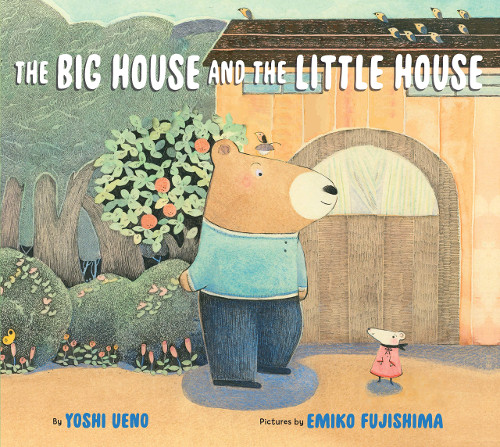A Stressful Sunday (But All’s Well That Ends Well)
 April 15th, 2021 by jules
April 15th, 2021 by jules
and went to work. Little Mouse to town, and Big Bear to the forest.”
(Click spread to enlarge)
Let’s take a look at a Japanese picture book import, originally published in 2012. Yoshi Ueno’s The Big House and the Little House (Levin Querido), illustrated by Emiko Fujishima, arrived on U.S. shelves last month.
On a long road there sits, at one end, a little house. At the other end is a big house. Little Mouse lives in the little house next to the river. Big Mouse lives in the big house next to an oak tree. Each lives alone. Their paths have never crossed. One day, they pass one another yet don’t lock eyes. (This is what happens when you stare straight ahead as you walk.) When they see crowds of people on an outing one day, each realizes how lonely they are. But! Finally. They meet one day in front of Big Bear’s house. They enjoy tea together. “You are my first guest ever,” Big Bear tells Little Mouse. “It’s great to drink tea with a guest!” They talk and talk. They even share their wishes with one another. (I love this.)
When a huge storm hits, Big Bear decides he must help Little Mouse, given that Little Mouse’s house is next to the river. His solution for keeping Little Mouse safe from the storm results in happy new circumstances for both friends. I was about to say that I don’t want to spoil the ending for you, but it is spoiled below in the selection of spreads I have for you today. (You’ve been warned.)
Ueno evidently worked as a children’s book editor for more than 40 years in Japan — and then decided to write children’s books. His text here is gently paced and sweet (but never cloying). Preschoolers (in particular) will be drawn to the plainspoken narrative and the two characters’ uncomplicated desires — to simply connect with another creature and form a friendship. The little details also delight, such as the size and appearance of each character’s home (Little Mouse’s roof!); Little Mouse’s bakery gig (she is so busy there that she has “no time to chat!”); the interior of Big Bear’s home; the affable community of creatures that surrounds them; and the way Little Mouse sits on an overturned tea cup when listening to Big Bear’s stories.
Fujishima brings readers a subdued palette of earth tones, and there is a lovely buttery (yet pale) canary yellow that dominates, infusing the book with cheer. Her depictions of the trees, hedges, and flowers on the long road where both characters live are especially intricate and textured. There is a delightful note on the copyright page that says:
“To create the artwork for this book , Emiko Fujishima first drew rough sketches of each scene. Then, on illustration boards, she began line drawings using 0.03mm to 1mm black drawing pens, building upon those lines to create value. Emiko added color by painting layers of pale watercolor. She added final details to her illustrations using drawing pens and colored pencils.”
HOW ABOUT THAT DETAILED ART NOTE?! (I love this too.)
Here are some spreads so that they can do the talking. (If you enlarge these images, you’ll see the gutter lines there. FYI.)

‘But the storm will wreck my house! What can we do?'”
(Click spread to enlarge)

I have an idea. Hold tight!’ yelled Big Bear. ‘Okay, Big Bear. Be careful!’
shouted Little Mouse from inside.”
(Click spread to enlarge)

Little Mouse came outside and smiled. ‘Thank you, Bear. That’s an excellent spot.'”
(Click spread to enlarge)

(Click spread to enlarge)

THE BIG HOUSE AND THE LITTLE HOUSE. Text copyright © 2012 by Yoshi Ueno. Illustrations © 2012 by Emiko Fujishima. Translation copyright © 2021 by Japan Foreign-Rights Centre with Arthur Levine. Originally published in Japan in 2012 as Okii Ouchi to Chȋsai Ouchi by IWASAKI Publishing Co., Ltd., Tokyo. Illustrations reproduced by permission of the publisher, Levine Querido, New York.

